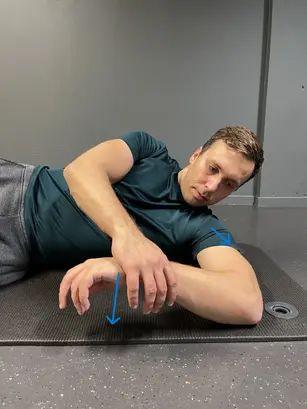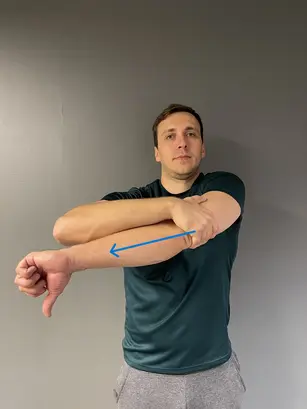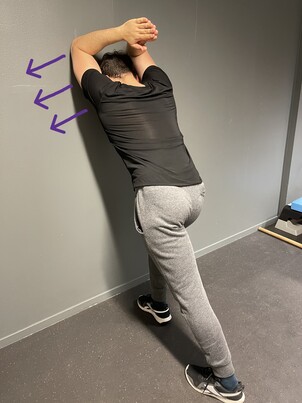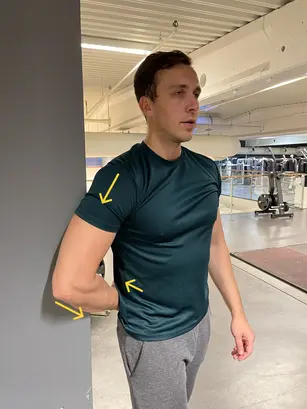How To Stretch Teres Minor Muscle: Ultimate Guide
Welcome to the ultimate guide on stretching the teres minor muscle!
If you’re an athlete, fitness enthusiast, or someone dealing with shoulder discomfort, you’ve landed on the right page. This comprehensive guide aims to be your one-stop-shop for understanding the anatomy, benefits, and techniques of stretching this crucial muscle.
So, buckle up as we delve deep into the world of teres minor stretching.
Let’s get started!
Basic Stretching Techniques: 4 Essential Stretches for the Teres Minor Muscle
Side Lying Teres Minor Strech
- Lie on your side
- Bend your elbow at a 90-degree angle
- Use your opposite hand to gently push your forearm toward the floor
- Hold for 30s
This stretch is easy to perform and targets also infraspinatus muscle.
Cross-Body Arm Stretch
- Stand up straight
- Extend one arm across your body at shoulder height
- Rotate your arm internally
- Use your opposite hand to pull the arm closer to your ches
- Hold for 30s
Standing Wall Stretch for Teres Minor and Lats
- Stand facing a wall
- Place your elbows on a wall above your head
- Lean forward with your upper body until you feel a stretch in your shoulder
- Hold for 30s
This stretch is excellent for stretching the lats and/or combating the rounded shoulders posture.
Wall Stretch For Rotator Cuff Muscles
- Stand sideways next to a wall
- Place your arm behind your back and on a wall
- Push gently your arm backward with your body, pushing your shoulder into internal rotation
- Hold for 30s
Advanced Stretching Techniques for the Teres Minor
PNF, an advanced stretching technique offers a deeper, more targeted approach to muscle flexibility and overall shoulder health.
Let me show you how to perform contract-relax PNF technique for teres minor muscle.
Assume the side lying teres minor stretch position. (see the picture below)
Step 1: Push your forearm toward the floor and hold this stretch for 30s.
Step 2: Push with your forearm against a resistance (your other hand) without moving your arm (static contraction) and hold for 6s.
Step 3: Continue into a deeper stretch by pushing your arm even more toward the ground. Hold for 30s.
Repeat the whole process five times more, each time going into a deeper stretch.
Anatomy of the Teres Minor
Understanding the anatomy of the teres minor is the first step in mastering how to stretch it effectively. So, what exactly is the Teres Minor, and why is it so important?
What is the Teres Minor Muscle?
The Teres Minor is one of the four muscles that make up the rotator cuff, a group of muscles and tendons that stabilize the shoulder. It’s a narrow, elongated muscle situated on the outer edge of the scapula (shoulder blade).
Location and Attachments
The Teres Minor originates from the lateral border of the scapula and inserts into the upper part of the humerus (upper arm bone). It runs alongside the Teres Major, but don’t get the two confused; they serve different functions.
Role in Shoulder Movements
The primary functions of the Teres Minor are:
- External Rotation: Turning the arm outward.
- Adduction: Bringing the arm closer to the body.
- Stabilization: Keeping the arm securely in the shoulder socket during various activities.
Why It’s Important
The Teres Minor is crucial for a variety of daily activities and sports movements. Whether you’re a swimmer executing perfect strokes or someone reaching out to grab a jar from the top shelf, this muscle is actively involved.
Real-Life Examples
- Baseball Players: Need a strong and flexible Teres Minor for effective pitching.
- Yoga Enthusiasts: Utilize the muscles in poses that require shoulder stability and rotation.
By understanding the anatomy of the Teres Minor, you’re better equipped to stretch it effectively and integrate it into your exercise and fitness routine. So, let’s move on to why stretching this muscle is so beneficial.
Why You Should Stretch Teres Minor Muscle?
Stretching teres minor muscle will improve the range of motion in your shuolder. Greater mobility allows for more efficient and fluid movements, making your daily activities easier or improving your sports performance.
Regular stretching can alleviate tension and tightness in teres minor muscle, which leads to reduced pain and discomfort in shoulder joint (especially for those suffering from rotator cuff injuries).
Having an optimal function of teres minor muscle helps stabilize the shoulder joint in both thrown or swimming activities.
Common Mistakes to Avoid When Stretching the Teres Minor
- Overstretching. Avoid stretching to the point of pain.
- Incorrect posture. Don’t sacrifice the quality of a movement when stretching to achieve greater ROM.
- Rushing through the stretch. Hold every static stretch for 30s. See stretching recommondation here.
- Skipping the warm-up. Stretching cold muscles is not recommended. Light cardio or dynamic stretches before static stretching.
- Stretching sporadically. Inconsistency limits long-term benefits.
Relevant Studies on Stretching the Teres Minor Muscle
Conclusion
Stretching the Teres Minor is an essential yet often overlooked aspect of shoulder health and overall physical well-being. From basic to advanced techniques, this comprehensive guide has aimed to be your ultimate resource for understanding and effectively stretching this crucial muscle.
Whether you’re an athlete, a fitness enthusiast, or someone simply looking to improve shoulder health, these stretches can make a significant difference. Remember, consistency is key, and it’s always a good idea to consult a healthcare provider for personalized advice.
Additional Resources
For those looking to dive even deeper into the subject, here are some additional resources:
- Books: Best Stretching Books for a more in-depth understanding.
- Equipment: Best Stretching Equipment for Home to enhance your stretching routine.
- Goniometer: Best Goniometer for measuring range of motion.
Related Articles
If you found this guide helpful, you might also be interested in:
Thank you for reading, and here’s to your journey towards better shoulder health and overall fitness!









